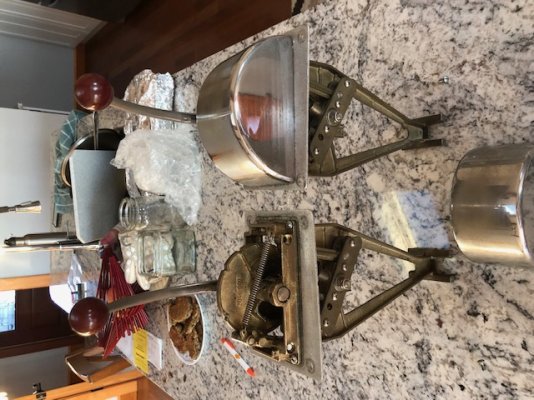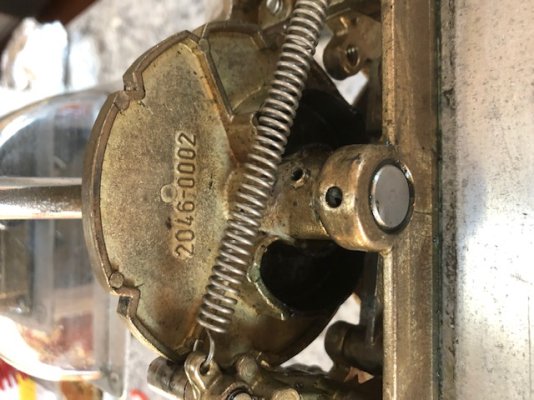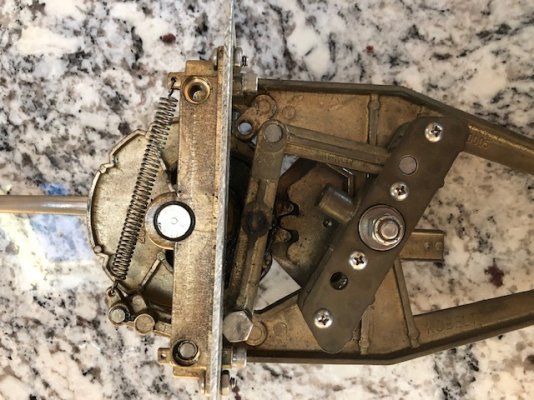You are using an out of date browser. It may not display this or other websites correctly.
You should upgrade or use an alternative browser.
You should upgrade or use an alternative browser.
Best throttle and transmission controls
- Thread starter Bigfish
- Start date
The friendliest place on the web for anyone who enjoys boating.
If you have answers, please help by responding to the unanswered posts.
If you have answers, please help by responding to the unanswered posts.
Jmarsh203
Senior Member
- Joined
- Sep 5, 2019
- Messages
- 302
- Location
- Where my boat is
- Vessel Name
- Chapter II
- Vessel Make
- 1972 42 foot Alloy Mfg
Kobelt. Money no object Kobelt is head and shoulders of better quality over Morse or any other I can think of. There are prob a few off brand European companies that can compete in the quality department but they will be just as expensive. Used kobelt is as or more expensive than new Morse and double new but they will last the lifetime of several boats.
Heard good things about Kobelt...
Just gotta say...
Original Morse controls still work great on our 1977 twin screw, twin pilot station Tollycraft.
Ya just gotta know how to "pressure lube" enclosed Morse cables all the way from top to bottom... without removal out of their normal working position. Also, keep the shift and throttle handle's internal knuckle joints lubed.
Well lubed they work like new - at 44 yrs old.
Just gotta say...
Original Morse controls still work great on our 1977 twin screw, twin pilot station Tollycraft.
Ya just gotta know how to "pressure lube" enclosed Morse cables all the way from top to bottom... without removal out of their normal working position. Also, keep the shift and throttle handle's internal knuckle joints lubed.
Well lubed they work like new - at 44 yrs old.
FF
Guru
- Joined
- Oct 12, 2007
- Messages
- 22,552
The 1960 era Morse single lever control cost $110. then , in todays dollars thats almost $1100.00.
A talk to a good used ships salvage ,Craigs list, or even just your local yard might find one.
The Navy use then in all their small boats , but cost was never a problem for them.
A talk to a good used ships salvage ,Craigs list, or even just your local yard might find one.
The Navy use then in all their small boats , but cost was never a problem for them.
O C Diver
Guru
- Joined
- Dec 16, 2010
- Messages
- 12,867
- Location
- USA
- Vessel Name
- Slow Hand
- Vessel Make
- Cherubini Independence 45
The Morse quality of 20 years ago is not what is produced to meet the price point of today. If you look at commercial small fishing and charter boats that get regularly used, Morse isn't what's chosen to replace the worn out controls.
Ted
Ted
Datenight
Guru
The 1960 era Morse single lever control cost $110. then , in todays dollars thats almost $1100.00.
A talk to a good used ships salvage ,Craigs list, or even just your local yard might find one.
Or just buy mine! Kobelt 2046. Bought used for the Green boat but sold it before I got to that project. $125.00 each plus shipping. Sorry about the background.
Rob
Attachments
Last edited:
O C Diver
Guru
- Joined
- Dec 16, 2010
- Messages
- 12,867
- Location
- USA
- Vessel Name
- Slow Hand
- Vessel Make
- Cherubini Independence 45
The 1960 era Morse single lever control cost $110. then , in todays dollars thats almost $1100.00.
A talk to a good used ships salvage ,Craigs list, or even just your local yard might find one.
Or just buy mine! $125.00 each plus shipping. Sorry about the background.
Rob
I believe those are Kobelt, not Morse.
Ted
kapnd
Guru
- Joined
- Aug 31, 2013
- Messages
- 879
- Location
- usa
- Vessel Name
- #31
- Vessel Make
- ex-Navy MUB 50 fish/cruise
Heard good things about Kobelt...
Just gotta say...
Original Morse controls still work great on our 1977 twin screw, twin pilot station Tollycraft.
Ya just gotta know how to "pressure lube" enclosed Morse cables all the way from top to bottom... without removal out of their normal working position. Also, keep the shift and throttle handle's internal knuckle joints lubed. Well lubed they work like new - at 44 yrs old.
Ok, I’ll bite.
How do you “pressure lube” your cables?
O C Diver
Guru
- Joined
- Dec 16, 2010
- Messages
- 12,867
- Location
- USA
- Vessel Name
- Slow Hand
- Vessel Make
- Cherubini Independence 45
Ok, I’ll bite.
How do you “pressure lube” your cables?
There are several YouTube videos on lubricating throttle and shifting cables. First saw it on house boats with insanely long cable runs.
Ted
Ok, I’ll bite.
How do you “pressure lube” your cables?
Fairly Simple [takes some effort and a bit of time - results can be impressive]:
- Off hook cable at pilot station control handle [of both/either-or at the throttle or trany control] for the cable you want to lubricate
- Off hook cable lower end at engine/trany - place good sized absorbent rag at that end of cable... paper towels work too. Small container [like empty mayonnaise or ketchup bottle] works also if placement area is good for that. Basically... this is to catch the overage lube you put into cable casing. After the lube begins to come out... leave things in place for a day or more - to get all the "extra" lube that will drip out.
- Put [pour into; or "preferably pressure force" - via spray can's straw] a good amount of thin viscosity lubricant into the casing around the cable. You can also put [gently force] thin viscosity lubricant into the casing by taping small rubber hose at end of casing and with funnel pour the lube into hose.
- Use small air pump [like a hand held bicycle or basketball pump] and seal its small hose onto cable casing top end or into the rubber hose; depending on how you got the lube into the control cable's plastic casing - get creative! Pump air pressure slowly. You can also blow with your mouth too! But, not recommended; due to saliva getting into the mix and lube on lips - ewww!
- Keep your eye on not adding too much fluid. Only pump air until the lube fluid begins to come out the cable end by engine or trany... thereat getting absorbed by the rags or captured by a container. Take your time and be careful to not put too much lube into the cable casing. Keep your eye on the low end. May take a while for the lube to get that far... i.e., to the low end.
Notes:
Main thing is to be creative. All you're doing is pushing lubricant into and having it travel throughout the cable's containment casing.
Depending on how sharp the "kinks" may be for your boat's cable layout [where it turns corners... etc] could affect how long it takes to get to the low end. Also, if there are locations where the cable actually points a bit upwards in its travels from its one end to another the pumping of air pressure is needed to continue for moving the new lube past that point. And, the longer the boat the longer the cable... patience is key!
While inserting the lube feel free to "exercise the cable by slightly pulling pulling pushing the cable inside its casing. Vise grip works wonders to do so.
YRMV!
 Good Luck!! - Art
Good Luck!! - ArtFF
Guru
- Joined
- Oct 12, 2007
- Messages
- 22,552
When cable lubing some folks use oil , which eventually can drain , others use undiluted green antifreeze as it leaves a slime that lasts inside the cable.
Circumnavigator
Senior Member
Kobelt.
And spend the extra $ for top end cables.
Jim
And spend the extra $ for top end cables.
Jim
What goes wrong? Why would cables need replacement?
Mine are 41 years old. I have been using them since 1994 and 3 owners before me since 1980. As far as I can tell they work the same now as they did in 1994 and in 1980. There are no signs of deterioration. Yet, when my Insurer asked for a Mechanical inspection, one of the things the "inspector" suggested (to me, but nothing about the cables appeared in his report) was that I should replace my Morse cables.
He made other "off the wall" suggestions so I am not convinced that he wasn't smoking something funny that day.
Mine are 41 years old. I have been using them since 1994 and 3 owners before me since 1980. As far as I can tell they work the same now as they did in 1994 and in 1980. There are no signs of deterioration. Yet, when my Insurer asked for a Mechanical inspection, one of the things the "inspector" suggested (to me, but nothing about the cables appeared in his report) was that I should replace my Morse cables.
He made other "off the wall" suggestions so I am not convinced that he wasn't smoking something funny that day.
rslifkin
Guru
- Joined
- Aug 20, 2019
- Messages
- 7,584
- Location
- USA
- Vessel Name
- Hour Glass
- Vessel Make
- Chris Craft 381 Catalina
What goes wrong? Why would cables need replacement?
Mine are 41 years old. I have been using them since 1994 and 3 owners before me since 1980. As far as I can tell they work the same now as they did in 1994 and in 1980. There are no signs of deterioration. Yet, when my Insurer asked for a Mechanical inspection, one of the things the "inspector" suggested (to me, but nothing about the cables appeared in his report) was that I should replace my Morse cables.
He made other "off the wall" suggestions so I am not convinced that he wasn't smoking something funny that day.
Cables can wear over time, particularly the inner liner that keeps everything sliding smoothly. But if they don't get dirt and water in them, don't get moved and kinked, etc. they can last a very long time if they're good quality cables. If they aren't showing any binding or excess friction and visually appear to be in good shape, I wouldn't worry about replacing them. Just monitor their conditions so you can replace them if they do start to wear out.
I contemplated replacing my shift cables this past winter after 34 years, as one of them was starting to get a bit stiff (even after lubrication). My hand was forced in the spring when I was backing into our slip one day and the stbd shift cable bound up hard (fortunately in neutral) and didn't want to move when I went to put that engine in gear. I did get it to move with a good bit of force after that, but there was no way I'd trust it.
Put in new shift cables after that and all is well (with lower shift effort than before). The throttle cables are still original, as those still seem to be in great shape with very little friction (so I see no reason to replace them).
Similar threads
- Replies
- 0
- Views
- 227



